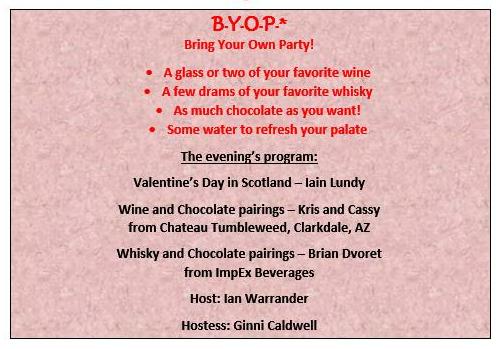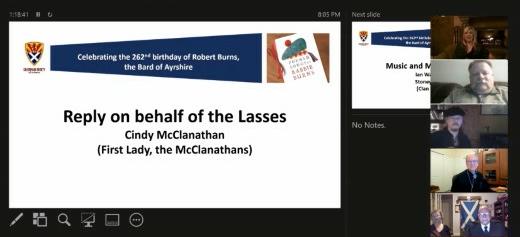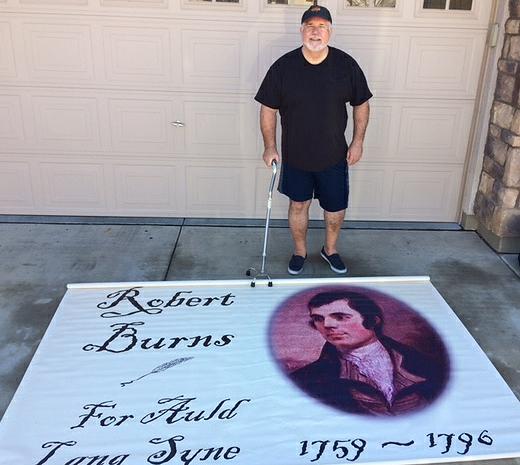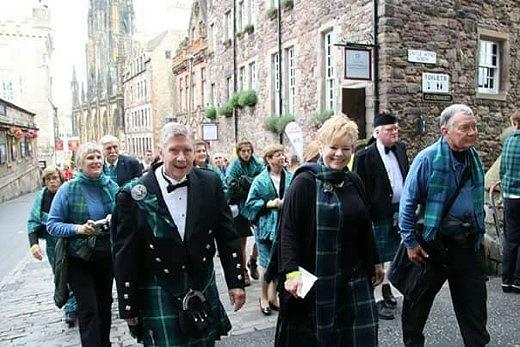Society News
Next Gathering on Zoom - Valentine's Day
Join us for a night of romance, chocolate, whisky, and wine when we celebrate Valentine’s Day in a uniquely Scottish way on Thursday 11 February.
The event will again be via Zoom but after the success of the Burns Supper, we are hopeful of another good attendance.
Make sure you have a dram of whisky or a glass of wine to hand. To put you in the mood we will have Kris and Cassy from Chateau Tumbleweed in Clarkdale on hand to explain the best combinations of wine and chocolate.
And Brian Dvorek from Impex Beverages will be suggesting the best kind of chocolate to go with the best single malt whisky.
Iain Lundy will also take a slightly irreverent look at how Valentine’s Day is traditionally celebrated in Scotland and asking if Scottish men are as romantic as they are painted.
The evening starts at 6:30pm. Keep an eye on the Facebook page for more details.

|
President's Letter
David McBee, President
.jpg)
We had a grand time with the Robert Burns Dinner celebration on Zoom. Many thanks to all who worked so hard to bring this event together. It was obviously very well received, and attendance swelled to about 60 people viewing. Live performance via Zoom can be quite tricky but the music was most appreciated. We learn more about how to work these Zoom meetings each time.
The situation has forced us to adapt and learn about meeting via Zoom. Some amazing opportunities are about to open to us with virtual events across the globe being hosted from Scotland. Being able to meet with great people in special places to celebrate events in Scotland live without spending money on travel is a reality that is now developing. I recommend you try to attend some of our Zoom meetings and get comfortable with the format and etiquette involved. There will be an array of virtual gatherings that we simply could not attend any other way over the vast distances and time periods involved.
This month’s whisky and chocolates gathering will be a fun way to see each other and enjoy some splurges of Valentines. Remember, it is the unique presence that each of you bring that makes the Society an enjoyable place to be.
Stay safe and sterilize with your sanitizer of choice. Scotch recommended.
Slainte.
DAVID
|
Kay Morneau
.jpg) The Society is saddened to learn of the passing of Kay Morneau – fondly known to all as “Grammy Kay”, a long-time CSA member who was active in the clan section when the Highland Games were held in Mesa. The Society is saddened to learn of the passing of Kay Morneau – fondly known to all as “Grammy Kay”, a long-time CSA member who was active in the clan section when the Highland Games were held in Mesa.
Kay, who grew up on the San Carlos Apache Indian Reservation and attended Globe High School, was for many years the Arizona Commissioner for Clan Chattan, a confederation of Scottish Highland clans that includes Mackintosh, MacBean, Macpherson, Farquharson, and Shaw, among others.
She helped run the Clan Chattan tent at the Games for several years and was very enthusiastic about her Scottish roots. Kay diligently took responsibility for the proper accommodation of James McBain of McBain as the ranking offical at our Games, Chief of Clan McBain and the Chattan Confederation.
A teacher by profession, she was passionate about a range of subjects including the history and geology of Arizona, family history, and was a member of the Daughters of the Gila County Pioneers.
Her obituary in the Arizona Republic stated, “Kay was the family historian and knew every family member and family line by heart, and she used these talents to reunite everyone for Thanksgiving each year.”
Kay’s daughter, Cathy LeVar, said her mother, who was 84, had visited Scotland in 2005 and 2007 and had “so much fun” on the trips. Cathy has offered the Society some of the Scottish books, maps, and other items her mother collected over the years, a gesture which we appreciate greatly.
|
|
James Lamie
Robert Burns may now be a long-distant historical Scottish figure. But one Society member has an ancestor with a strong connection to the great poet. He was even said to have been with Burns when he gained inspiration for one of his best-known works.
.jpg) James Lamie, who lived in Mauchline, Ayrshire, at the time of Burns, was the 5th great grandfather of CSA member Linda Lambie. By all accounts the two men were friends, and Lamie is one of the Mauchline Kirk elders featured in a 1947 book, The Song in the Green Thorn Tree, about the life and loves of the Bard. James Lamie, who lived in Mauchline, Ayrshire, at the time of Burns, was the 5th great grandfather of CSA member Linda Lambie. By all accounts the two men were friends, and Lamie is one of the Mauchline Kirk elders featured in a 1947 book, The Song in the Green Thorn Tree, about the life and loves of the Bard.
Lamie was supposedly with Burns when his plough accidentally destroyed a mouse’s nest, inspiring his famous poem To a Mouse.
In the 1947 book, written by James Barke, Lamie was described as “a strict narrow-visioned man with little imaginative faculty” and “a disciplinarian who regretted that the Kirk had given up its uniquely-varied instruments of torture.”
The two men were obviously well-known to each other. Mauchline was and still is a small market town where everyone knows everyone else. And it should be a sense of pride for the Society that we can boast a member with such a close connection to the Bard.
|
|
Scotland's Hidden Gems - Plockton
Iain Lundy, Editor
.jpg) Imagine a main street lined with palm trees running through a small village in the West Highlands of Scotland. Sound unlikely? Well, if you don’t believe me take a trip to Plockton and see for yourself. Imagine a main street lined with palm trees running through a small village in the West Highlands of Scotland. Sound unlikely? Well, if you don’t believe me take a trip to Plockton and see for yourself.
Plockton sits a few miles north of the Skye Bridge and its tropical appearance is due to the North Atlantic Drift – an extension of the Gulf Stream – which warms the water and gives the area an unusually mild climate.
The New Zealand cabbage palm trees were planted in the 1960s and are now a unique attraction.
It is well worth a visit if you are in the area. Although it is the size of a typical Highland village, it has a distinctly different feel. There are, of course, plenty guest houses and a few bars, but there is an arty-crafty feel that other places lack.
Plockton styles itself the “Jewel of the Highlands” and very few people would argue. The village sits in a sheltered bay on the shores of Loch Carron and enjoys spectacular views of the surrounding mountains. It can be reached by car or train from Inverness or nearby Kyle of Lochalsh.
.jpg)
The village has had a rough history. It suffered greatly during the Highland Clearances and the famines that hit Scotland in the mind-1800s. There was once a thriving herring industry, but the industry collapsed when the fish changed their migration pattern.
In the 1990s, salvation appeared in the unlikely arrival of a BBC drama series. Hamish Macbeth was a quirky series about a Highland policeman, always accompanied by his West Highland Terrier called Wee Jock. Filmed in and around Plockton, it starred Robert Carlyle (of The Full Monty fame) and put the little Highland village firmly on the tourist map.
Nowadays it is a popular spot thanks to its natural beauty and well worth a visit. And if you find yourself there, be sure to visit the nearby hamlet of Duirinish, where Highland cattle roam free in the village streets.
|
|
Research Your Scottish Ancestry
|
|
 Photos and Genealogy Photos and Genealogy
by Robert M. Wilbanks IV, B.A.
Chief Genealogist & Historian, C.S.A.
genealogy@arizonascots.com
While “A picture paints a thousand words,” photos can write your family history into an expansive novel, or even a movie. Old family photos greatly add to your research success, as well as help present a detailed visual of your genealogy, offering a wealth of additional information and surprising details.
This article intends to very briefly let you know of the many various benefits and best methods for utilizing, incorporating, and preserving old family photos.
Understanding the history of photography, the art form and industry, and the historic types of photos, can add to dating and preserving old photos. Some distinguishing types of photos include Daguerreotypes (1840s-early 1860s), Ambrotypes (1855-1865), Tintypes (1856-1890s), Cartes des Visites (1859-early 1900s), and Cabinet Cards (1860s-early 1900s). While dating photos based on type can help identify family members, knowledge of the family can also help narrow down the dates of events in the photos.
Awareness of the ‘provenance’ of photos, where they came from, how they belonged to the family, etc., can be important in utilizing them as documentation of family stories, information, history, etc. Combined with known information of the family, this ‘provenance’ can add to the knowledge, and fill any gaps, of any missing information.
Learning the notable fashion, the furniture of the times, and the locations in the photos, can also help with dating and identifying localities of photos, or confirming persons, etc.
While the above factors can add to the life and stories of the ancestors within the family history, other aspects of photos in genealogy include conservation and preservation, filing and organizing, including employing new high-tech tools and resources.
Various manners of materials can be found in a family collection of old photos, such as individual photos, glass plate negatives, slides, negatives, photo albums, etc. Thus, conservation and preservation of these old family photos is becoming a bigger part of genealogy. This includes handling, identifying, and storing, such as wearing gloves, utilize pencil versus pen or marker, other forms of labeling, archival photo boxes and binders for storing and organizing.
New exciting advances in technology are really adding to the photo possibilities in genealogy, such as digitizing for preservation, storing and sharing, and incorporating into writing family histories and websites and genealogy blogs. For example, there are new technologies to help digitize slides and negatives, or to digitize damaged photos and restore them electronically. Other technology tools include the many websites popping up where photos with unknown locations or family members can be shared in the hopes that someone else can help with identification. There are also new facial recognition programs that can help compare the people in your photos with the vast number of identified photos on the internet. And there is new developing software that helps utilize facial recognition to connect unidentified photos with current living family members based on similarity of inherited features.
If you don’t have family photos of your ancestors, you are likely to find them on the internet through standard genealogy subscription sites, such as Ancestry, FamilySearch, FindMyPast, etc. Meanwhile, there are various other genealogy photos web-sharing sites, and unidentified photos sites, such as AncientFaces, DeadFred, Flickr, and many more. Additionally, consider online historical museums, universities, libraries, archives and more, to locate historic and potentially old family photos.
Meanwhile, also consider locating and utilizing historical photos that indirectly can be added to your family history, such as old cars, military ships, downtown and main street photos, old buildings and farms, school photos, fraternal organizations, and so much more. This can really add to the story and appearance of your history.
There are extensive numbers of websites, blogs and YouTube videos, etc., with information and instruction on all aspects of photos as it relates to genealogy. Utilize various combinations of the search terms such as photos, genealogy, organizing, preservation, etc., to find these many internet sites that can help you learn about old photos and how to incorporate them into your family history.
Photos can truly be a fun and exciting aspect and addition to include in your family history. So, learning more about photos can be significant. Have fun and good luck.
This is another of a series of articles in which I show you the basics of searching for your family history, discussing the use of family records, public records, and online resources nationally and internationally, etc. The previous articles are now available on the Genealogy Section of this website. See “Genealogy” in the menu options at the top of the web page.
|
Burns Night on Zoom
The Society’s virtual Burns Supper held on 23 January was a rousing success. More than 60 participants joined the Zoom event and enjoyed a cracking night of music and entertainment in memory of the Scottish Bard.
Even though we were online and not meeting in person, many traditional Burns Supper features were kept. Musicians Iain Walinck and Aaron Shaw kept the audience entertained with renditions of some of Burns most beautiful and stirring compositions, including Ae Fond Kiss, A Man’s a Man for A’ That, and My Love She’s but a Lassie Yet.
Carolyn Kunz got the proceedings off to a grand start with her Address to the Haggis. Pat Schuller gave the traditional Toast to the Lasses and the reply was given by Cindy McClanathan.
All in all it was a great night and proof that, if we all make the effort to get together, we can still enjoy each other’s company – at least virtually.
 Follow this link to download the recording of the recent 2021 Burns Night Presentation. It is a large MP4 video file, which may take a while to download depending on your connection speed
Follow this link to download the recording of the recent 2021 Burns Night Presentation. It is a large MP4 video file, which may take a while to download depending on your connection speed
|
|
|
|
Burns Banner Donation
by Iain Lundy
The CSA has received a generous gift of a vinyl banner of Robert Burns that stands 6 ft tall and 8 ft wide. It was presented to us by fellow Arizonan Don Burns, who designed it when he lived in California.
Mr. Burns was active in Scottish circles when he lived in northern California and organized and attended many Burns Suppers over the years. He is moving to a smaller home in Tucson and had no room for his impressive Burns banner.
The banner has thin PVC pipes sewn in to make sure it stays flat when displayed. We will proudly display it at future events. Thank you Don!

|
|
|
|
World Wide St. Andrew's Day
A Scottish musician is planning a worldwide event in November to celebrate Scotland’s Patron Saint, St Andrew. Bruce MacGregor hopes to stage a major concert on 30 November, as well as a range of other events over that weekend.
Bruce is well known in Scottish music circles. His band, Blazin Fiddles has been together for 22 years, and he hosts a BBC radio show called Travelling Folk. He wrote to the CSA and other Scottish societies worldwide to outline his idea.
“I am writing to you to see if you would be interested in participating in a global St Andrew’s day/week celebration. We are developing plans to put on a St Andrew’s Day concert live from the Usher Hall in Edinburgh on the night of 30 November and in addition developing a host of fringe events in the weekend leading up.
“These involve other concerts, whisky tastings, cooking demonstrations and a dance. Obviously, all these events will have to take into consideration the effects of the pandemic and so we plan on doing everything online with the hope of being able to do some of it in front of a live audience.
“We hope to be able to sell online tickets for events to the entire Scottish diaspora in an effort to really celebrate St Andrew’s on a global scale. It has always disappointed me that St Patrick’s Day is celebrated globally yet St Andrew’s Day has never had the same impact. I want to change that.”
He has had initial discussions with Creative Scotland about possible funding for this ambitious project and is asking for people and societies abroad to prove to the funders that there is a desire for such an event.
|
|
Our Clan Representatives
Clan Oliphant has yet to set up a tent at the Phoenix Scottish Games. The plans were well under way when Covid 19 came to town and the Games were cancelled. However, Tom and Ginni Caldwell have been a part of the Phoenix Scottish Games since 2014. Tom is the President of the Oliphant Clan and Family Association of North America. Oliphant has a long and distinguished history/ Here are 10 fascinating clan facts.

1. The Oliphant Clan Chief’s motto is ‘A tout pourvoir’ (Provide for all) and the crest features a unicorn’s head. Lord Oliphant’s Coat of Arms features the unicorn and motto with two rampant elephants and three crescents argent against a red background (gules).
2. Carolina Oliphant (1766–1845), named in memory of ‘Bonnie’ Prince Charles Edward Stuart, was famous for writing Jacobite songs and her many sobriquets. Nicknamed ‘pretty Miss Car’ at school for her striking beauty, and ‘Flower of Strathearn’ for her pleasing manners, Carolina became Lady Nairne through marriage. Although her songs, such as Charlie is my Darling, Land o’ the Leal, The Rowan Tree and A Hundred Pipers, were hugely popular in her time – second only to Robert Burns – due to Carolina’s social standing she kept her identity secret, even from her husband, using the name Mrs Bogan of Bogan.
3. Timothy Olyphant (born 1968) is an American actor and producer who has appeared in the films Scream 2 and Oliver Stone’s Snowden, the TV legal thriller Damages and the US version of British sitcom The Office. He can be found in Netflix series The San Clarita Diet, alongside Drew Barrymore.
4. Due to the absence of a Chief for 250 years and to Clan Oliphant’s historic importance, other clans have erroneously laid claim to the name in the 19th century. The Clan Chief, Richard Eric Laurence Oliphant of that Ilk, is also Chieftain of the Condie branch and only three further Chieftains remain today: Laurence Oliphant of Ardblair and Gask, Philip Oliphant of Rossie and David Olyphant of Bachilton.
5. The Oliphant name comes from David de Olifard who saved the life of King David I during the siege of Winchester Castle in 1141 and was changed after encountering the oliphantus (the form word for elephant) in the crusades. Today, the highest distribution of the surname in Scotland occurs in Fife, the Highlands, Perth and Kinross, and Dundee and Angus.
6. Sir Marcus ‘Mark’ Laurence Elwin Oliphant (1901–2000) played an important role in the first experimental demonstration of nuclear fusion and the development of nuclear weapons. After the physicist retired, he was appointed Governor of South Australia, assisted in founding the Australian Democrats party and became a campaigner for voluntary euthanasia.
7. South African-born Laurence Oliphant (1829–1888), was a writer, diplomat and one of the first Christian Zionists. He was first secretary of the British legation to Japan, suffering permanent damage to one of his hands during a night-time attack in Edo, and was an MP for several years. In 1868 he joined a religious community in California and eleven years later, settled in Palestine. He died in England.
8. Australian cartoonist Pat Oliphant (born 1935) won the 1967 Pulitzer Prize for Editorial Cartooning for “They won’t get us to the conference table… will they?” and many other accolades including the National Cartoonist Society Editorial Cartoon Award seven times. His trademark is a small penguin called Punk.
9. Thomas Oliphant (1799–1873) was an artist and author but primarily known as a musician and lyricist. In 1863 he wrote the Chorale for the wedding of King Edward VII and Queen Alexandra. Oliphant’s ability to translate foreign songs into English was a much sought-after skill in Victorian Britain. His words for the yuletide tune, Deck the Halls with Boughs of Holly, are still sung today as a Christmas carol.
10. Margaret Oliphant (1828–1897) was a highly distinguished 19th century novelist, essayist and historical and travel writer. She published more than 120 works and was avidly read by Queen Victoria, Darwin, Gladstone and Virginia Woolf among others. She contributed to Blackwood’s Magazine and also wrote supernatural fiction including the ghost story A Beleaguered City.
|
|
|